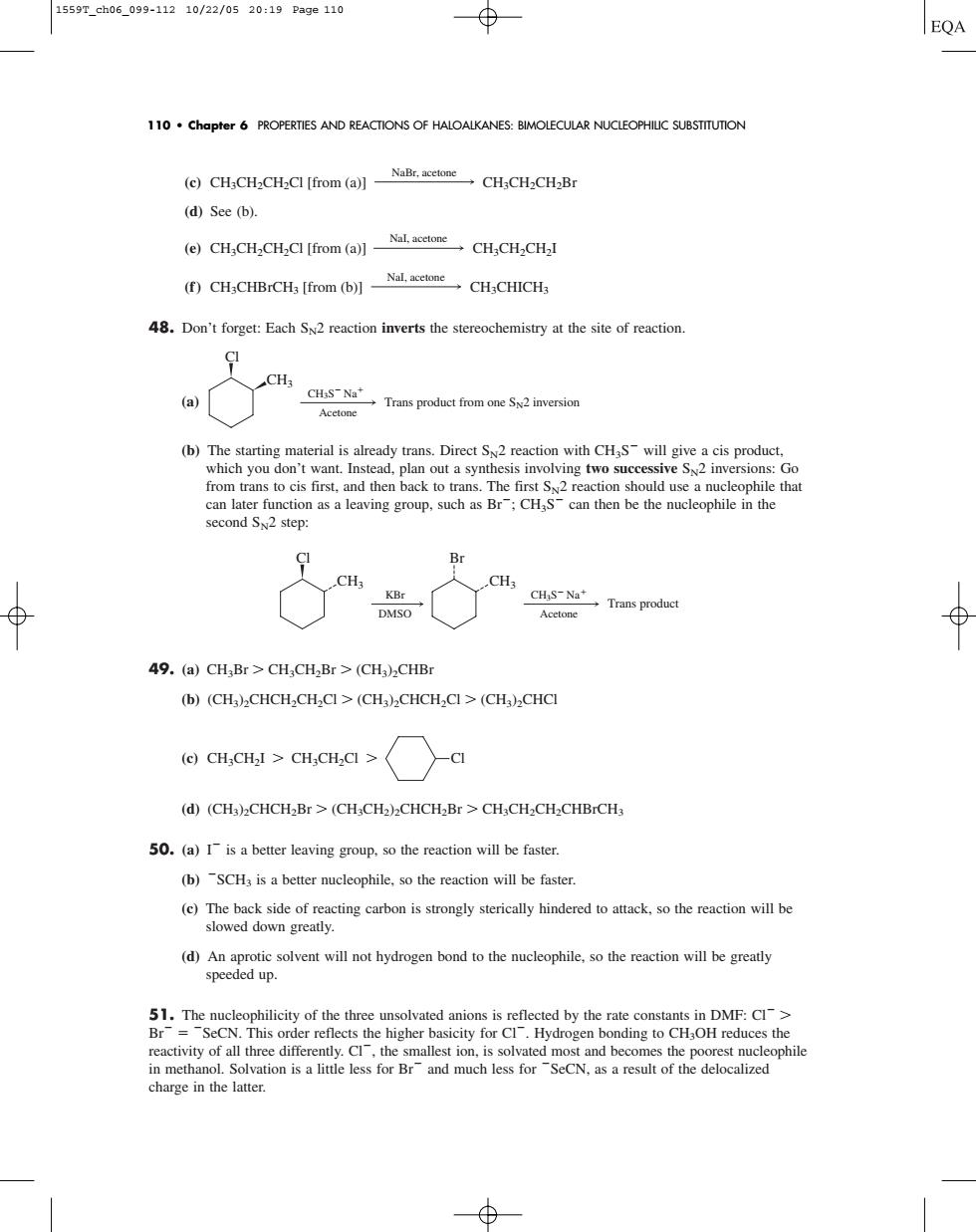正在加载图片...

1559r.ah06_099-11210/22/0520:19Page110 110 chapter 6 PROPERTES AND REACTIONS OF HALOALKANES:BIMOLECULAR NUCLEOPHILIC SUBSTTTUTON (e)[from (a)] (d)See (b) (e)CH,CH,CH.CI Ifrom()CH,CH.CH-I (f)CHaCHBrCHa [from(b)] Nal.,CHICH3 48.Don't forget:Each SN2 reaction inverts the stereochemistry at the site of reactior CH (a) CH:S-Na" Trans product P second S2 step: Br CH; CH,S-Na Trans produc 49.(a)CH Br>CH;CH,Br (CH)2CHBr (b)(CH)2CHCH2CH2CI>(CH3)2CHCH2CI>(CH)2CHCI >>○ (d)(CHy)2CHCH2Br>(CH.CHa)2CHCH.Br>CH.CH2CH.CHBrCH 50.(a)Iis a better leaving group,so the reaction will be faster (b)-SCHa is a better nucleophile.so the reaction will be faster (e)The back side of reacting carbon is strongly sterically hindered to attack,so the reaction will be slowed down greatly. ic solvent will not hydrogen bond to the nucleophile.so the reaction will be greatly 51.The nucleophilicity of the three unsolvated anions is reflected by the rate constants in DMF:Cl> Br=SeCN.This order reflects the higher basicity for Cl.Hydrogen bonding to CHOH reduces the t uch le seC. ophil charge in the latter.(c) (d) See (b). (e) (f ) 48. Don’t forget: Each SN2 reaction inverts the stereochemistry at the site of reaction. (a) (b) The starting material is already trans. Direct SN2 reaction with CH3S will give a cis product, which you don’t want. Instead, plan out a synthesis involving two successive SN2 inversions: Go from trans to cis first, and then back to trans. The first SN2 reaction should use a nucleophile that can later function as a leaving group, such as Br; CH3S can then be the nucleophile in the second SN2 step: 49. (a) CH3Br CH3CH2Br (CH3)2CHBr (b) (CH3)2CHCH2CH2Cl (CH3)2CHCH2Cl (CH3)2CHCl (c) (d) (CH3)2CHCH2Br (CH3CH2)2CHCH2Br CH3CH2CH2CHBrCH3 50. (a) I is a better leaving group, so the reaction will be faster. (b) SCH3 is a better nucleophile, so the reaction will be faster. (c) The back side of reacting carbon is strongly sterically hindered to attack, so the reaction will be slowed down greatly. (d) An aprotic solvent will not hydrogen bond to the nucleophile, so the reaction will be greatly speeded up. 51. The nucleophilicity of the three unsolvated anions is reflected by the rate constants in DMF: Cl Br SeCN. This order reflects the higher basicity for Cl. Hydrogen bonding to CH3OH reduces the reactivity of all three differently. Cl, the smallest ion, is solvated most and becomes the poorest nucleophile in methanol. Solvation is a little less for Br and much less for SeCN, as a result of the delocalized charge in the latter. CH3CH2I CH3CH2Cl Cl CH3S Na CH3 Br Acetone KBr CH3 Cl DMSO Trans product CH3S Na CH3 Cl Acetone Trans product from one SN2 inversion CH3CHBrCH3 [from (b)] CH3CHICH3 NaI, acetone CH3CH2CH2Cl [from (a)] CH3CH2CH2I NaI, acetone CH3CH2CH2Cl [from (a)] CH3CH2CH2Br NaBr, acetone 110 • Chapter 6 PROPERTIES AND REACTIONS OF HALOALKANES: BIMOLECULAR NUCLEOPHILIC SUBSTITUTION 1559T_ch06_099-112 10/22/05 20:19 Page 110����������������